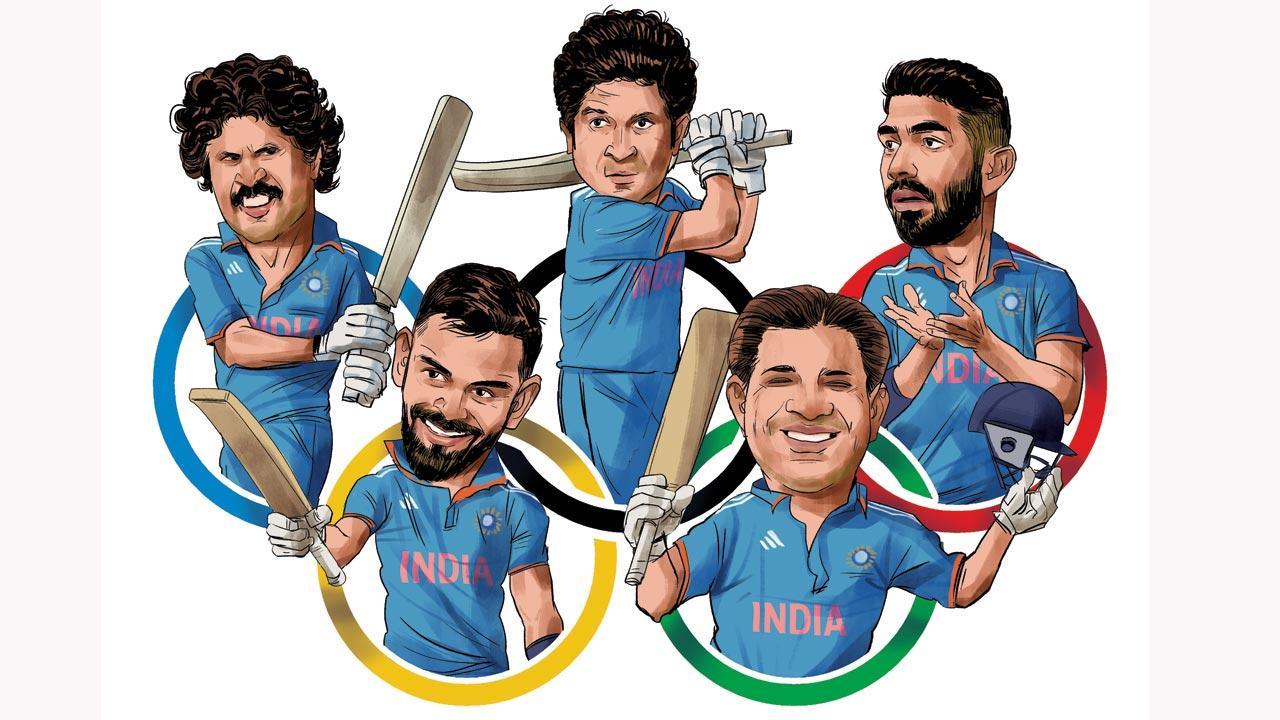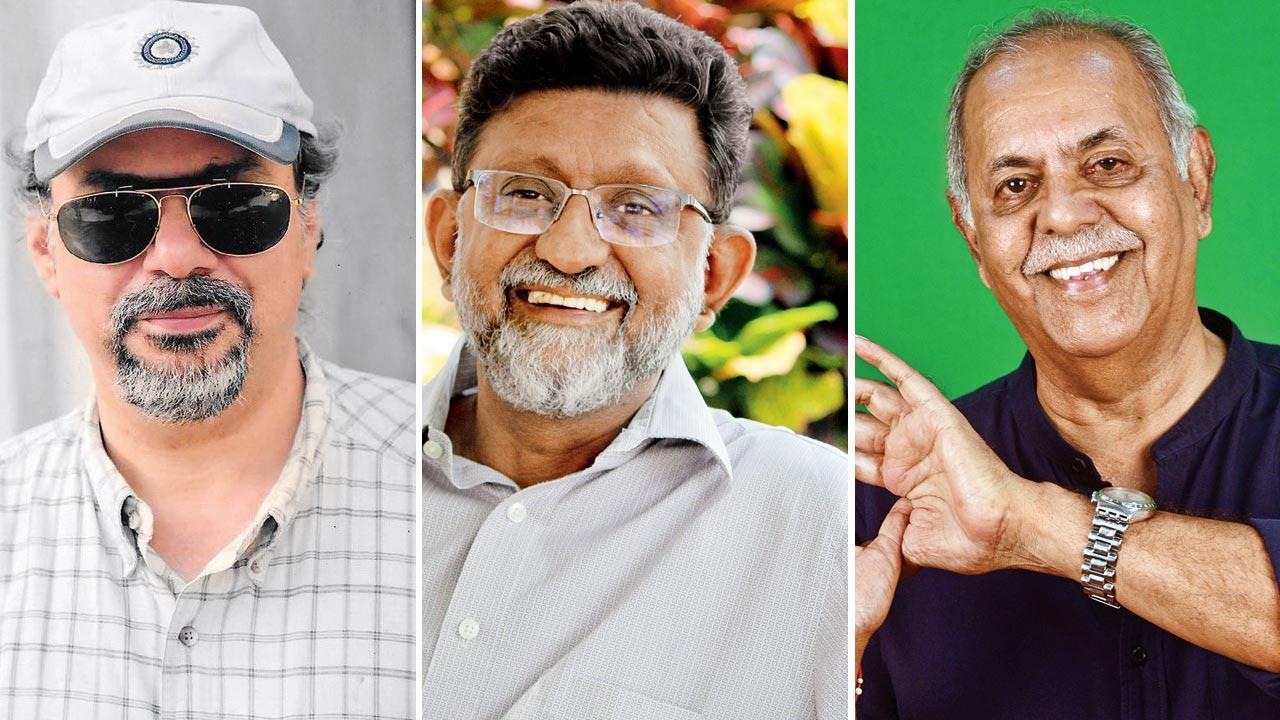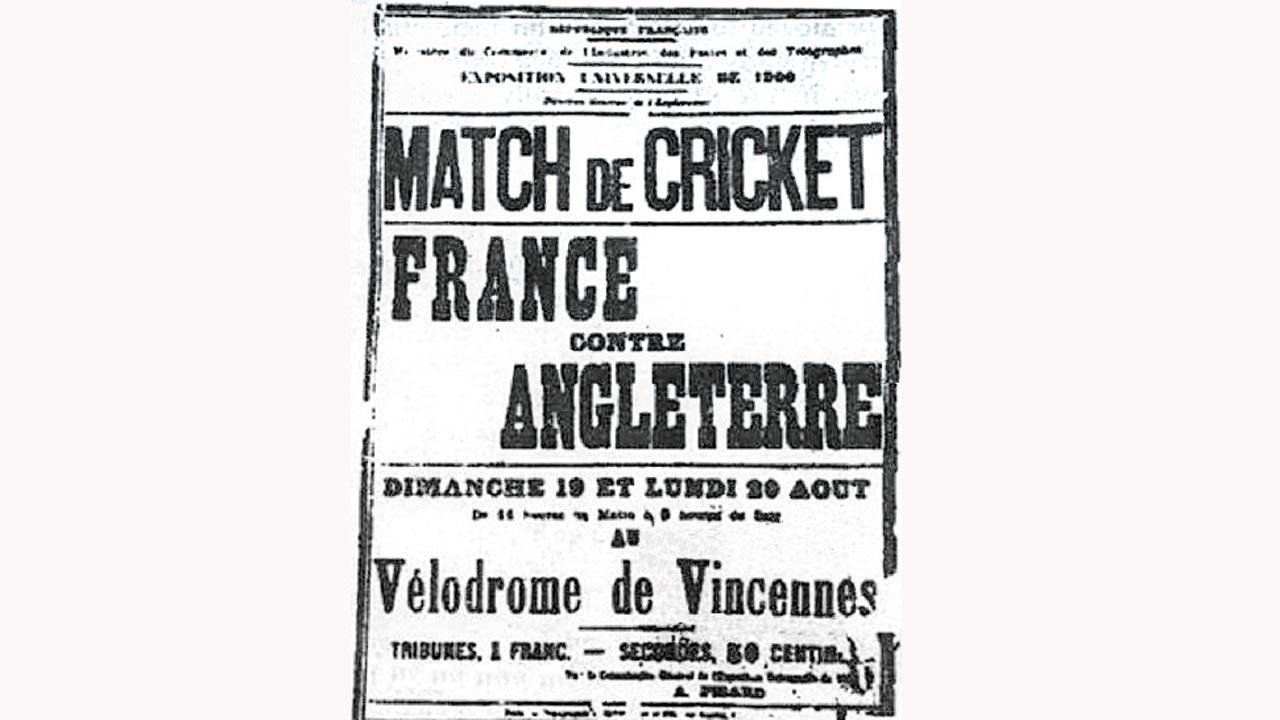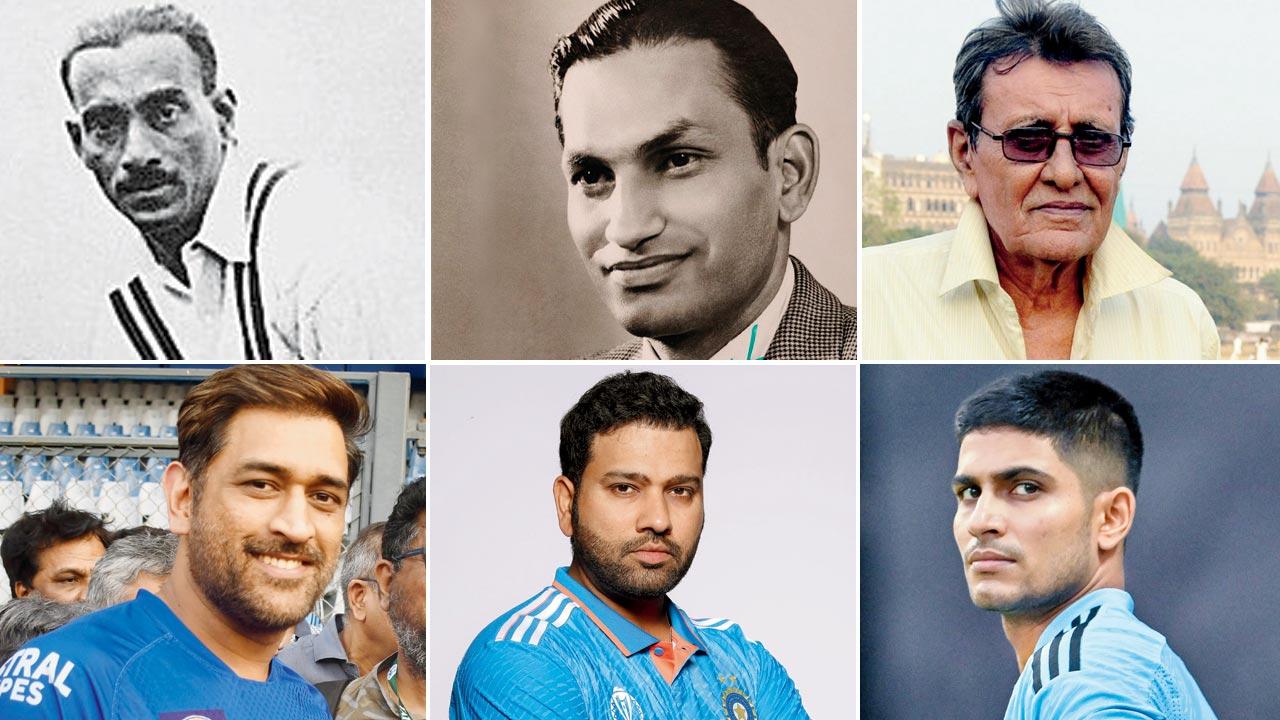With cricket set to make a return to the 2028 Los Angeles Olympics 128 years after its insipid debut, experts tell us why it’s good for the sport, and even brainstorm a Team India dream line-up for Sunday mid-day

Illustration/Uday Mohite
The first and the last time cricket was played at the Olympics was 123 years ago. This was the 1900 Paris Summer Olympics, cricket historian Gulu Ezekiel tells us over a phone call. Apart for Great Britain and France, Belgium and Holland (now Netherlands) were also due to participate, but withdrew later.
ADVERTISEMENT
“In the end, there were only two teams, Great Britain and France,” he says. While the British side was a touring club, the Devon and Somerset Wanderers, the French team, comprising members of the French Athletic Club Union, was made up of only English expatriates who were either travelling or living in Paris. “Basically, there were no French players in the French team,” says Ezekiel. Each team had 12 players, instead of the standard 11-a-side contest. And the match which was played at the Vélodrome de Vincennes, otherwise a cycling venue, on August 19, lasted only two days. “It wasn’t even a Test match, because for Test cricket, you need 11 players in each team, and the game has to be played for a minimum of three days,” Ezekiel points out. Great Britain with a slim score of 117 had been declared winner, after bowling out their French opponents for 78. But such was the apathy towards the match, it didn’t get covered in any national newspaper, according to reports. “The results were not included as part of the official records of the players.”
 Gulu Ezekiel, S Giridhar and Yajurvindra Singh
Gulu Ezekiel, S Giridhar and Yajurvindra Singh
The winning English side didn’t even get a gold medal. Reports indicate that they got medals made of silver, while the French side received bronze medals. “All players were given miniature statues of the Eiffel Tower.”
That the Paris Olympics itself had been a damp squib, did little for the game. “It was a poorly organised event, with a lot of unusual events being added to the roster,” says Ezekiel. “The Olympics nearly collapsed because of this fiasco.”
 Poster of the only Olympic cricket match played in 1990. Pic/Wikipedia
Poster of the only Olympic cricket match played in 1990. Pic/Wikipedia
After this, cricket only made its presence felt at a multi-sports event a century later, at the 1998 Commonwealth Games in Kuala Lumpur, and then at the 2010 Asian Games. It’s taken a while to embrace cricket as medal sport, but more good news came last week, when the International Olympic Committee (IOC), confirmed the inclusion of T20 cricket in the 2028 Los Angeles Olympics (LA28). “…the most important argument is: we have seen the growing international importance of cricket,” IOC president Thomas Bach said, while speaking at the IOC session in Mumbai. “The Olympic Games want to represent and want to incorporate the most popular sports worldwide. And here it came together that this sport also has a growing importance in the United States. Therefore, this proposal was very much welcome.”
International Cricket Council chairperson Greg Barclay, who attended the IOC session, described the Olympic inclusion, as a “great opportunity to grow the game”. “Particularly in areas where we are perhaps under-represented. It’s a great outcome. And it’s a win-win for both [cricket and] the Olympics.”
There are many likely reasons for the sport having had to wait all these years, to find a berth again. Cricketer writer S Giridhar, who has co-authored the new edition of Mid-Wicket Tales: A Century and More of Cricket with VJ Raghunath, says, “Cricket is a very distinct game, a fussy game. It demands a lot more logistics/facilities than other sports. For example, in games like football, hockey or baseball, the court or playing area, the duration, rules etc remain the same, whether you play at the Olympics or any other tournament. But in cricket, you have Tests, 50-over and T20 with different duration and playing rules. And then there is the weather. We can manage many other sports even if it rains, play indoors too, but cricket matches get ‘abandoned’ if it rains.”
Tests, he says, are impossible to play in the Olympics. Even 50 overs cricket takes an entire day. Now, with T20 becoming a major form of cricket, a window of opportunity has opened to introduce it at the Olympics. “T20 has made it possible to squeeze in several matches in a day.” “Also, though England, India and Australia continue to be the three largest countries in terms of revenue-generation for the sport, the game is slowly spreading, and there is now a significant representation across many countries.” This, he says, is in keeping with the spirit of the Olympics, “which is to include a sport that is played by a number of countries”.
However, the IOC’s decision to have only six participating teams—including a team of the host nation United States—at the 2028 LA Olympics, might put the game in a peculiar position, feels Ezekiel. “That leaves us with five other teams,” he says, “If India, Sri Lanka, Pakistan and Bangladesh qualify, it would be almost like the Asian Games.” Veteran Indian cricketer Yajurvindra Singh expresses a similar concern. “The six-team format is not ideal at all. We have to have many, many more teams,” says Yajurvindra, who is currently in Malaga, Spain for the European Cricket Championship. “There are 31 European teams participating in the T10 format there.
You have Netherlands, Spain, Italy, Germany that are playing.” Olympics, he believes, is an event where you can get all these countries involved. “It’s not about winning, it’s about participating.” He feels that there should be at least 20 teams playing, and in a shorter format like T10. “Once the format shrinks, the difference between [competing] sides become that much less. In T10, you need just one or two players to really perform, and every team has them. Afghanistan [which won against England last week at the ICC World Cup match] has shown us that. In the end, you want see more participation, more competition and many countries involved. Olympics is a great platform to do this.”
But will fans be completely hooked when it’s played at the Summer Olympics? “For cricket, the ICC World Test Championship, the World Cup for 50 overs and the T20 World Cup are the main tournaments,” says Giridhar. “In such a calendar, will an Olympics Trophy occupy the kind of pedestal that hockey or basketball Olympics Trophy holds is to be seen.”
India Olympics XI
What would a Dream XI India team look like at the Olympics? We asked cricket nuts and veterans to suggest players from across generations, perfect for the short format game. This is what they came up with
 CK Nayudu, Syed Mushtaq Ali, Salim Durani, MS Dhoni, Rohit Sharma and Shubman Gill
CK Nayudu, Syed Mushtaq Ali, Salim Durani, MS Dhoni, Rohit Sharma and Shubman Gill
Vinoo Mankad
“He was among the finest and greatest all-rounders India has ever had,” says Yajurvindra Singh of the late cricketer, who played 44 Tests for India, scoring 2,109 runs at an average of 31.47 and taking 162 wickets at 32.31. “He made us win all the Test matches that he played, and was a tremendous performer with the bat and the ball,” says Singh, explaining why he would have wanted to see him in the Olympics squad.
CK Nayudu
“Although the story of him smashing a six that hit the Rajabai Clock Tower while batting from the far end of the Bombay Gymkhana, lends itself to more fiction than fact, India’s first Test captain could hit the ball hard and high,” says mid-day’s Group Sports Editor Clayton Murzello. He’d be a crowd-puller as popular and revered as a Tendulkar or a Kohli.
Kapil Dev
According to cricketer and commentator Aakash Chopra, if Kapil Dev had played today, he would have been the “biggest T20 rockstar”. “With his bowling, batting, and fielding, he is a complete package. We don’t have anyone like him. And because, we’ve missed watching him play the shortest format, it would be a treat,” thinks Chopra. Amre agrees. “He is a natural choice for this game. He scripted history when he won the 1983
World Cup.”
Syed Mushtaq Ali
The trophy named after this great Indian batsman for India’s T20 championship seems so right, says Murzello. “Mushtaq would have been a T20 star
which an Olympic audience would adore. He was instinctive in his cricket, impatient too and that’s not a great disadvantage to have in the shortest form of
the game.”
Salim Durani
The dashing Indian cricketer who ruled Indian cricket in the 1960s, and passed away in April this year, would have been the perfect fit, feels India cricketer Pravin Amre. “Sir Gary Sobers called him ‘Sir’… that sums up the kind of respect he commanded. He was one of greatest of all times. People say that he would hit sixes on demand. Even his bowling was brilliant. It’s really difficult to find an all-rounder like him.”
MS Dhoni
The Ranchi player is the perfect finisher, says Chopra. “You’ve got magical hand behind the stump, an astute cricket mind, and an absolute legend of the game… what else do you need?” asks Chopra. “From a selfish point of view, as well as a global point of view, it would be nice to have him there.”
Sachin Tendulkar
“What is a game after all, without India’s biggest and finest ever batter?” asks Chopra. Having played over 200 Test matches, and 463 ODIs, he has the gift of experience that very few players in the world have, adds Amre, “Not to forget, his consistency with the game. It’s not for nothing that he is called the Lord
of Cricket.”
Rohit Sharma
There’s a reason why he is called The Hitman, smiles Amre. The current India captain has the most sixes in international cricket with 556 sixes in 473 innings, going past Chris Gayle’s record tally of 553 sixes across formats. “I have seen his journey as a 16-year-old, and his debut for Mumbai Ranji, and winning the IPL five times as captain. His achievements are simply remarkable,” says Amre.
Virat Kohli
The right-handed batsman is the finest chase master in India’s cricketing history, according to Amre. “As cricketers, we all know how difficult it is to chase targets. But he has shown us the way, and made it look so simple,” he says.
Shubman Gill
Yajurvindra believes that in 2028, Shubman Gill would lead India as captain. The right-hand top-order batsman from Punjab is known for his penchant for big runs, and for a format that needs big hitters, nobody fits perfectly. “He is a naturally dashing player, and is young enough to be in the team.”
Jasprit Bumrah
Bumrah is the greatest T20 bowler India has ever produced, shares Chopra. Amre adds, “The way he is bowling at this point, he is a stand-out performer, and just perfect for the format at the Olympics.” Singh calls him a deceptive bowler. “People are not able to fathom him at all, and with age he is only going to
get better.”
 Subscribe today by clicking the link and stay updated with the latest news!" Click here!
Subscribe today by clicking the link and stay updated with the latest news!" Click here!







